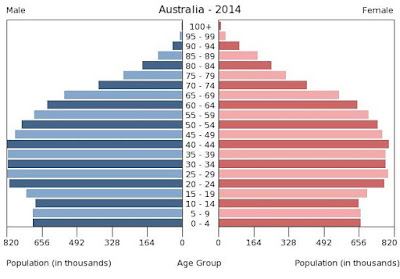People of Australia
Population: 22,751,014 making Australia the 56th
largest country in the world.
Median age:
total: 38.4, male: 37.7, female: 39.2 years
 |
| Source:
|
Population growth
rate: 1.07%
Birth rate: 12.15
births/1,000 population
Death rate: 7.14
deaths/1,000 population
Urban population:
89.4% of total population
 |
| Source: |
Largest city: Sydney
4.505 million
Infant mortality rate:
4.37 deaths/1,000 live births, ranked 188th in the world
Life expectancy at
birth: 82.15 years, ranked 13nd in the world
Total fertility rate:
1.77 children born/woman, ranked 159th in the world
HIV/AIDS
·
adult prevalence rate: 0.17%. ranked 100th in
the world
·
people living with HIV/AIDS: 28,200, ranked 74th
in the world
·
deaths: Fewer than 100, ranked 105th
in the world
Obesity - adult
prevalence rate: 29.9%, ranked 44th
 |
| Source:
|
Literacy (age 15
and over can read and write): 99%
Unemployment:
11.7%, ranked 93rd in the world
Recommended Vaccines
for Travelers: Hepatitis A, Hepatitis B, Japanese Encephalitis, Rabies, and
Yellow Fever.


